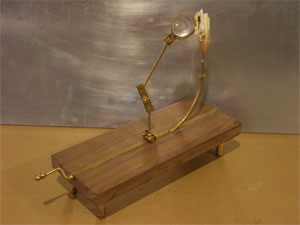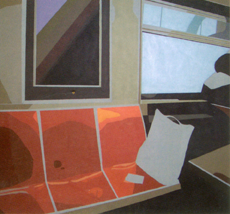I went down to Newark on Thursday night to find a whole different world. I've mostly stayed with the Chelsea scene, and the Chelsea scene is about money. Not all of the artists who show there are established and successful, but the galleries themselves are financed with a lot of money: Chelsea may be inexpensive for Manhattan but it's still astronomically expensive. Actually I don't think there's a bad (and therefore affordable) neighborhood left on Manhattan Island; if there is, it's way way way uptown. By contrast, Newark is pretty much one big bad neighborhood. Newark is one of those cities which the government is always throwing money at in an effort to "revitalize" it, but so far it's valiantly resisted all such attempts. So visiting Red Saw Gallery is like stepping into a time warp and seeing what the Village looked like when the Abstract Expressionists were working there, or maybe like dropping in on the Cubists at the beginning of the 20th century. At Red Saw a small group of artists have cobbled together gallery/party/studio/living space and are living the stereotypical artist's life of material poverty and, one hopes, creative wealth.
As per standard operating Newark procedure, I had to break about seventeen traffic laws -- turning left when I wasn't supposed to, going the wrong way down a one way street, driving on the trolley tracks -- to find Red Saw and park. Upstairs I found Jeanne Brasile sitting in on a meeting of the Red Saw principals. Jeanne wanted me to talk to Asha Ganpat, but in the meantime we wandered off together to talk without disturbing the meeting. We were shortly joined by Seth Goodwin, who -- probably because he liked Jeanne -- brought us back to his studio to show us what he's working on, and then to his bedroom, which -- in keeping with the poverty theme -- actually has no windows, although it does have a connection to the Internet.
 Seth is a sculptor, I guess you'd say: He assembles these contraptions out of metal tubing and animal teeth and wooden boxes and magnifying lenses and cranks and other odds and ends, creating what look like things out of a Victorian dream filtered through a whimsical Clive Barker. If you can imagine such a thing.
Seth is a sculptor, I guess you'd say: He assembles these contraptions out of metal tubing and animal teeth and wooden boxes and magnifying lenses and cranks and other odds and ends, creating what look like things out of a Victorian dream filtered through a whimsical Clive Barker. If you can imagine such a thing.
One of his projects, called Curious Tokens, I liked very much. He made these little objects and placed them in a few different places around the city. Then he went back every so often to see if he could find out what happened to them. The story of one piece was fantastic: He placed it in an alcove above a shop, and the woman who runs the shop thought it was some witchcraft or Santería working and wigged out and had a ritual to remove it, ending with putting it into a garbage can outside and pushing it down the street with a broom.
I like this. You might not think I would: Ordinarily my focus is on the end result. Show me a work of art and I'll tell you if I like it or not. I'm not interested in process, or what the artist intended, or context, or how many rich bozos paid how much for it. The proof, to me, is in the final object, never mind what went into making it. That's usually how I feel. But sometimes I'll turn it around, and Seth's project is one of those times. I love it when art surprises people, when it turns up some unexpected place, when it causes a reaction not constrained by being labeled as "art." Outside a gallery, outside a studio, dropped off somewhere without any attribution -- that's the way art can really hit people. Sometimes it just knocks them off balance a little, and maybe sometimes they go nuts and think someone is hexing them, but in the end at least it's shaken something up.
When we made it back to the gallery the meeting had ended but Asha was now talking with this artist who had brought in a piece for an upcoming show on the theme of toys. The woman had made some blocks in standard kindergarten shapes but had made them out of lead, so you have to handle them with gloves. I'm not exactly sure what that's supposed to be about, but Asha cooed appreciatively over the blocks, eventually joined by Jeanne. I hung back as the conversation wounds its way around to being about men and what terrible people they are.
 I spent my time looking over the gallery's current show, "Interiors" by Douglas Czuszak. Douglas' paintings remind me of Brian Alfred's, although they lack some of his precision. They're slightly more emotional. Still, Douglas' work has a certain coldness to it, a distance. They're supposedly of memories but don't have the warmth or ambiguity I'd expect from a memory; there's no sentimentality and, to me, little sentiment. These paintings are spare, sparse, and a bit empty.
I spent my time looking over the gallery's current show, "Interiors" by Douglas Czuszak. Douglas' paintings remind me of Brian Alfred's, although they lack some of his precision. They're slightly more emotional. Still, Douglas' work has a certain coldness to it, a distance. They're supposedly of memories but don't have the warmth or ambiguity I'd expect from a memory; there's no sentimentality and, to me, little sentiment. These paintings are spare, sparse, and a bit empty.
Eventually I got my chance to talk to Asha and show her the drawings and painting I'd brought. Meeting Asha gives me a sense of how small the art world is -- particularly the northeast New Jersey art world -- since Jeanne wanted me to meet her; and Asha's Website has a link on it to Cory Marc's Website, which I designed; and Asha and Cory know each other, also.
After talking to Asha, the next reason Jeanne had me come to Newark was to stop by 27 Mix to see the paintings there. Alexandra Pacula, a friend of Jeanne's, was showing four large works. After seeing my painting of the George Washington Bridge Jeanne thought I'd like Alex's paintings, and she was right. Alex's work looks like she starts with digital photographs taken with a slow shutter speed. Dark areas are lit by smears of colorful light; people are blurry shapes. There's an element of The Night Cafe, with man-made illumination being the main subject. Alex's paintings vibrate with energy, like the shaky hands of a late-night photographer. The only flaw is Alex doesn't have a Website or many images online: To give you an idea, I found this image, but it's not what she has up now.
![[Alexandra Pacula]](/blog/images/20060323/alex_pacula.gif)
It is, of course, too early to tell if Red Saw is where we'll find the next Jackson Pollock or Mark Rothko, or if it's just some self-indulgent exercise in bohemia for would-be hipsters. I tend to think that the New York art world is all about the subways: Brooklyn was the next big thing -- Dumbo and Williamsburg -- but the money is following the art, as so often happens, and it's getting too expensive for up-and-coming artists to live and work there, probably, and so the artists are going to have to move farther out. New Jersey spots like Newark and Paterson are actually closer to midtown Manhattan than the hinterlands of Queens and Long Island, but I suspect the gaze of the art world will keep moving that way simply because even the distant reaches of Brooklyn and Queens are still connected by the subway system -- and New Jersey public transportation sucks ice cubes through a crazy straw. But I guess we'll see, won't we?


Leave a comment